MORE GREAT DESTINATIONS IN PROVENCE!
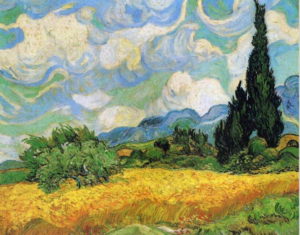
The very name ‘Provence’ conjures up images of brilliant blue skies, ancient golden stone villages with terracotta tiled roofs, and dazzling colours thrown into sharp relief as depicted in a Van Gogh painting. It’s a land of languid, hot sunny days, leisurely outdoor dining on wonderful food that tastes of sunshine, with the air fragrant from fields of lavender. It’s also a region whose architectural riches of its ancient past are evident at every turn.
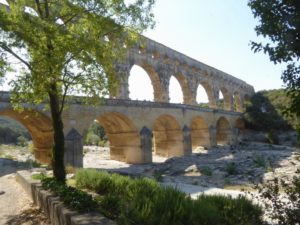
If we’re going to Provence from Paris we tend to take the TGV to Avignon, pick up our rental car from the station and often head to the spectacular Pont du Gard, which is only 28 km away. This incredible Roman aqueduct never fails to be an awe-inspiring sight, and a visit now is even more enjoyable, since a lot of work has been done to improve the presentation and visitor experience in the last few years. Vehicles—notably the large tour buses—are no longer allowed to park close to it, and the ticket office is now located inside a very impressive visitors’ centre.
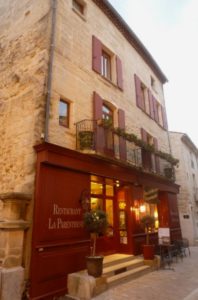
Just a few kilometres from the Pont du Gard the picturesque small town of Uzès is a perfect place for an overnight stay. We like to head to the Hostellerie Provençal, a charming small hotel in a 300 year old building, with an excellent roof-top terrace restaurant, very conveniently located on the ring-road that denotes the line of the old Roman walls.
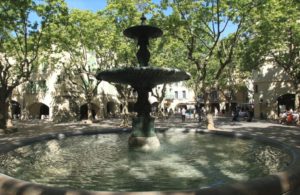
The old town is full of charm with an abundance of heritage riches, blending Medieval, Renaissance and classical architectural styles throughout its alleyways, squares, monuments and private mansions. Above all, don’t miss the Place aux Herbes, a square lined with shady plane trees, a pretty fountain in the middle, and surrounded by a beautiful arcade of houses, nowadays filled with café terraces and small shops.
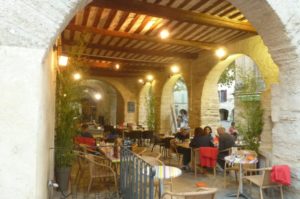
It’s also where a traditional Provençal market takes place every Saturday. In July, a well-regarded music festival, ‘Les Nuits Musicales d’Uzès’ takes place in a number of venues including the ducal palace, St. Théodorit cathedral and the courtyard of the bishop’s palace.
If we’re ultimately heading for the Luberon, we tend to save the glories of the Roman towns of Avignon, Arles, Orange and Nimes for a trip devoted solely to these gems, since they all have so much to see, deserving of many days for each.
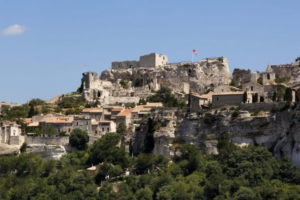
En route across to the Luberon a brief stop for a few hours at one of the most unique hill-top towns of Provence, Les Baux de Provence, is a must. Designated as one of the Plus Beaux Villages de France, this fortified medieval village is high on a rocky promontory just 10 kms from St Rémy de Provence.
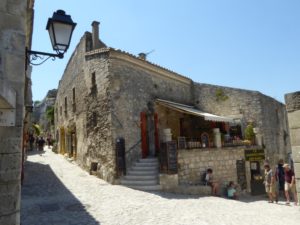
The long, narrow main street is lined in grey stone Medieval buildings that are now occupied with any number of tourist-oriented shops filled with a large range of good quality Provençal ceramics, dried herbs, lavender, tableware, and local gourmet treats. Far from decrying the commercialism that seems to have taken over the town, it has in fact been the reason for the town’s resurrection from an abandoned ruin into a vibrant, economically secure, living village once more.
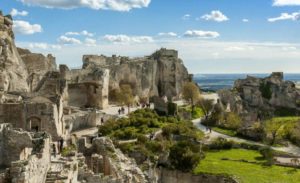
The stony path continues up to the extensive ruins of the fortress-chateau. Once in the grounds, the steep path leads past troglodyte caves on the way to the most breathtaking view, from where you can see as far as Aix-en-Provence, Mont St Victoire towards Marseille, and in another direction, towards Arles and the Camargue.
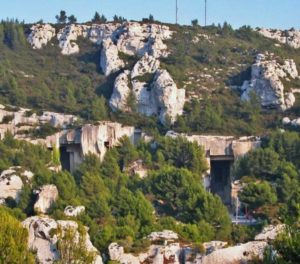
A few hundred metres from the chateau is one of the highlights of Les Baux de Provence. A wonderful exhibition space, the Carrières des Lumières located in a monumental former quarry, is operated by the Culture Spaces group, which recently opened the fantastic Atelier des Lumières in Paris.
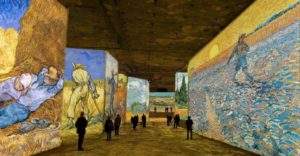
It was here that they first developed the concept and techniques of their extraordinary multi-media, digital art shows.
En route from Les Baux de Provence to St Remy, the road passes by the impressive archaeological site of Glanum which is well worth visiting.
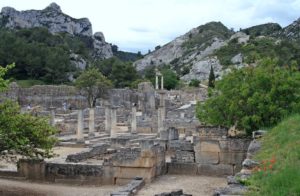
There are traces of human habitation dating back to 2500 BCE and the first Gallic tribes around 600 BCE. However, today it’s the ruins of its monuments built under the Roman Empire, including a triumphal arch, the forum, various temples, baths and theatres that remain.
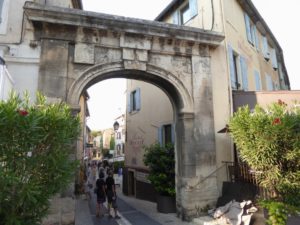
The town of St Rémy de Provence is one of the most beautiful in Provence. The town is encircled by the remnants of the circular 14th century wall that protected the village, whose original street pattern dates back to the Gallo-Roman era. The old portes are still in use today as the entrances into the historic centre.
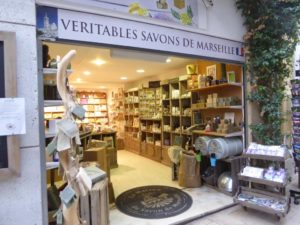
There’s nothing so pleasant than to simply meander around the narrow little streets, discovering squares where fountains play, and the numerous boutiques, stylish homewares shops, and art galleries that makes the historic centre so lively. Needless to say, there are many cafes and restaurants specialising in local Provençal cuisine using the rich bounty of the vicinity—unsurprising, since St Rémy is in the heart of a rich region of gastronomy!
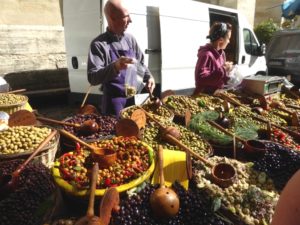
St Rémy is at the foot of the Alpilles, and from here you can experience the magnificent landscapes of the Massif des Alpilles. On Wednesdays it has one of the best markets in the region that spreads through the historic centre of town, where you’ll find everything imaginable made from the olive, from oil, olive wood bowls and chopping boards, miniature olive trees in pretty little terracotta pots and of course, the olives themselves.
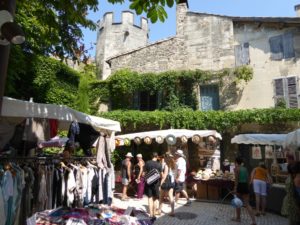
Food is everywhere, as well as honey, flavoured vinegars, wonderful local garlic, locally-made soaps (I especially love the fleur d’oranger and the amande) and local linens. There’s a smaller market on Saturdays, with food only.
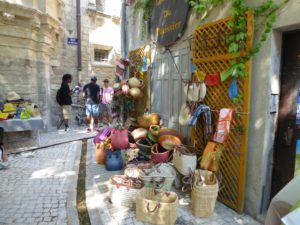
The town is famous for numerous historic figures including Nostradamus, who was born here in 1503; the composer Charles Gounod who lived here for a few months in 1863 while he composed his opera ‘Mireille’; Dr Albert Schweitzer who was hospitalised here in 1917-18 for the remainder of the war; most people though would immediately think of Vincent Van Gogh, who voluntarily entered the Asylum de Saint Paul Mausole (since renamed Clinique Van Gogh) just outside St Rémy, for a year before relocating, under the care of his doctor, to Auvers-sur-Oise, where he ended his own life. Van Gogh painted around 150 works during his year in St Rémy.
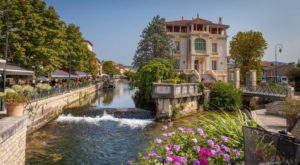
L’Isle-sur-la-Sorgue: is in the departement of Vaucluse at the foot of the Vaucluse plateau. It is simply one of those places in Provence that one has to see. The river Sorgue surrounds the town and canals snake through the town’s narrow streets. These are crossed by little footbridges, and there are a number of enormous waterwheels with mossy blades slowly turning in the water. Pretty cafes with colourful canvas awnings and vivid potted geraniums line the canals, making them the perfect place to adjourn for a leisurely lunch.
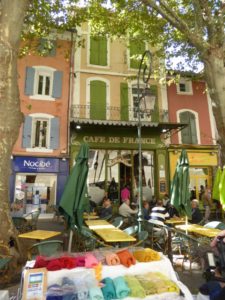
The most famous café in town is the picture-perfect Café de France, but it’s always crowded and there’s no lack of other great choices.
Many magnificent mansions have been turned into art galleries, in particular the former Hotel Donadei de Campredon, built in the 18th century. It’s now the Maison René Char, a museum displaying works by many great artists including Miro, Maugin, Dufy and a space dedicated to the writings of Char, many of which were illustrated by contemporary notable figures in the art world such as Picasso, Kandinsky, Miro and Matisse.
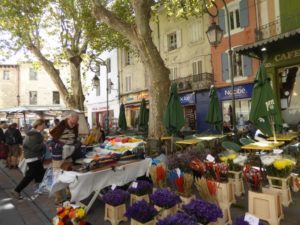
The Sunday market is the largest in Provence, and one we never miss. It’s essential to get there early to find a parking space within walking distance of the town centre. The entire historic centre is given over to the market and needless to say has every imaginable edible delight, all from the local area. It’s also known as one of the region’s best flea markets. We also love browsing through the numerous stalls selling great linen fashions in stylish, easy shapes for both women and men that are perfect for hot summer days in Provence, as well as good quality panama hats, colourful straw baskets, olive oil products and great ceramics.
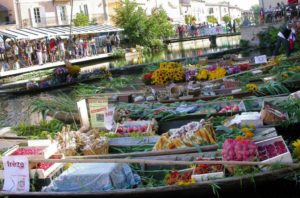
If you’re going to be in Provence in high summer, make sure to head to Isle-sur-la-Sorgue on the first Sunday of August. At the same time as the regular Sunday market an annual event takes place, ‘Le Marché Flottant’ (floating market) on the canal across from the public garden.
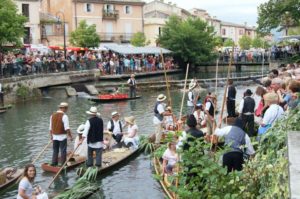
Traditional boats of the town, called “nego chins”, manned by boatmen wearing traditional Provençal costume, answer the public’s calls and ply back and forth across the canal with their boats laden with local produce such as fresh fruit and vegetables, flowers, cheese, wine and bread. As the floating market draws to a close, the nego chins gather in a line and, along with the vendors of the regular market, sing a famous Provençal song the “Coupo Santo”.
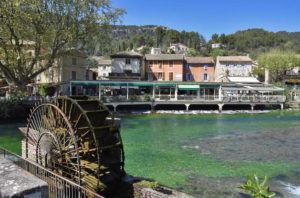
Fontaine de Vaucluse: Is in the departement of Vaucluse but as it’s so close, we often like to include it when we’re in the Luberon. Situated at the foot of a steep limestone cliff some 230 metres high, the village is squeezed into the end of a deep, narrow valley. It takes its name from the beautiful and mysterious spring feeding the river Sorgue, the largest in France. The incredibly deep water is a startling emerald colour. The spring is actually the river gushing out from an immense underground network of run-offs of rainwater and melted snows from Mount Ventoux, Mont de Vaucluse and Mont Lure. The only place this water comes out of the ground is at Fontaine de Vaucluse. In the summer and winter the waters are calm and peaceful, but in the wetter seasons of autumn and spring it becomes a spectacular sight as the raging torrent crashes onto the rapids a few metres from the pool, and turning a number of waterwheels before passing under the bridge at the centre of the village.
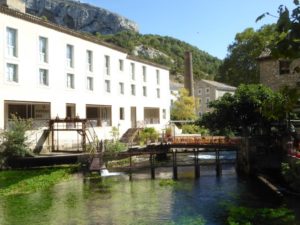
Said to be blessed by the gods, the spring was an ancient pilgrimage site known as Vallis Clausa, and celebrated in classical literature, notably by Seneca, and later by Petrarch. There’s a Musée-Bibliothèque Pétrarque (Petrarch) in the Italian poet’s former residence dating from the 14th century.
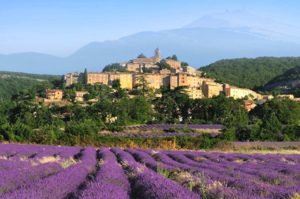
One of the most fascinating places to visit in the Vaucluse is the perched village of Crillon-le-Brave. Grouped on a rocky hilltop, this white stone village claims to have the most beautiful panoramic view of Mont Ventoux and up to the Rhone Valley. Known to have been occupied since Neolithic times, vestiges of the Roman occupation have also been unearthed. At the end of the 19th century, Crillon-le-Brave was a prosperous village of approx. 800 inhabitants but by the 20th century the village began slowly to decline, mostly due to the two world wars and an uncertain water supply. The town was named for a leading Avignon family in the 14th century who acquired the feudal rights to the village. The same Crillon family also gave its name to the famous Hôtel de Crillon in Paris.
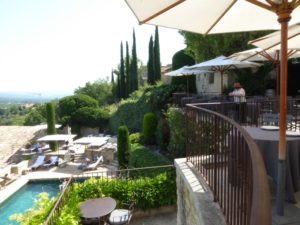
In 1989 a number of cottages in the village were purchased and turned into a small hotel. Over time, more houses were acquired, along with stables that were converted into a spa. In 2018 the hotel was purchased by the current owners, who did a complete makeover. The original buildings were meticulously restored, including an abandoned school, and one of the most luxurious spa hotels in the South of France was established, and is now a member of the prestigious Relais et Chateaux group.
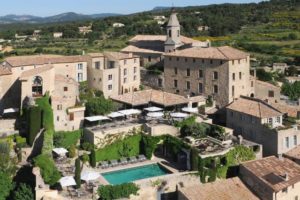
Perched at its very top, the hotel managed to achieve the look and feel of being an integral part of the village, with stunning, panoramic views overlooking Mont Ventoux and the countryside full of olive groves and vineyards that produce the AOC Côtes-du-Ventoux wines. The village itself is tiny, with cobble-stoned streets and stairways, and a maze of 17th and 18th century buildings covered in Virginia creeper, grouped around the church. It’s one of the best, most atmospheric hotels we’ve ever stayed in, and long to return one day.
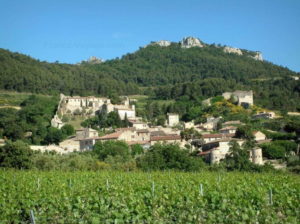
This is a part of Provence that many visitors tend not to reach, which is understandable, given the enormous distractions spread across the region. However, as an easy detour 38km northeast of Avignon, 35km east of Orange, and only 14km from Carpentras, it’s a rewarding and very different addition to a Provençal adventure.
I’m a great believer in having something to look forward to, especially during very trying times such as we’re experiencing now—it’s a great motivator to stay positive about the future.
Armchair travel allows us a brief escape to wonderful places and the freedom to think about all kinds of future possibilities. Perhaps now is the perfect time to plan some new destinations to explore when the world once more becomes our travel oyster!
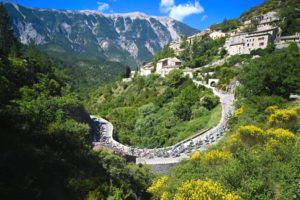
Let me know if you’d like to chat about your future travel ideas–perhaps exploring Provence. And if you’re thinking of heading to Paris, I’m sure to have some interesting suggestions for you.


You’re giving me itchy feet. I’m very much afraid it will be a while before they’re scratched
though.
Thank you, this brought back such wonderful memories of our time in Provence. We stayed in the village of Eygalieres at Mas des Cistes and went on day trips to the places you have mentioned. It was a lovely place and even had the most fantastic dental service used by my sister for a nasty abscess. I would thoroughly recommend Eygalieres.
Hi Diane,
That’s what armchair travel is for, isn’t it? Bringing back happy memories and perhaps offering a few new thoughts. So agree about Eygalieres: we stayed in a lovely little hotel called Hotel La Bastide d’Eygalieres back in 2015, and like you, would highly recommend the town. There are so many delightful parts of Provence to explore–it offers more variety perhaps than almost any other region in France–this blog post could easily have been 3 times as long! Lovely to hear from you. Cheers, Cheryl